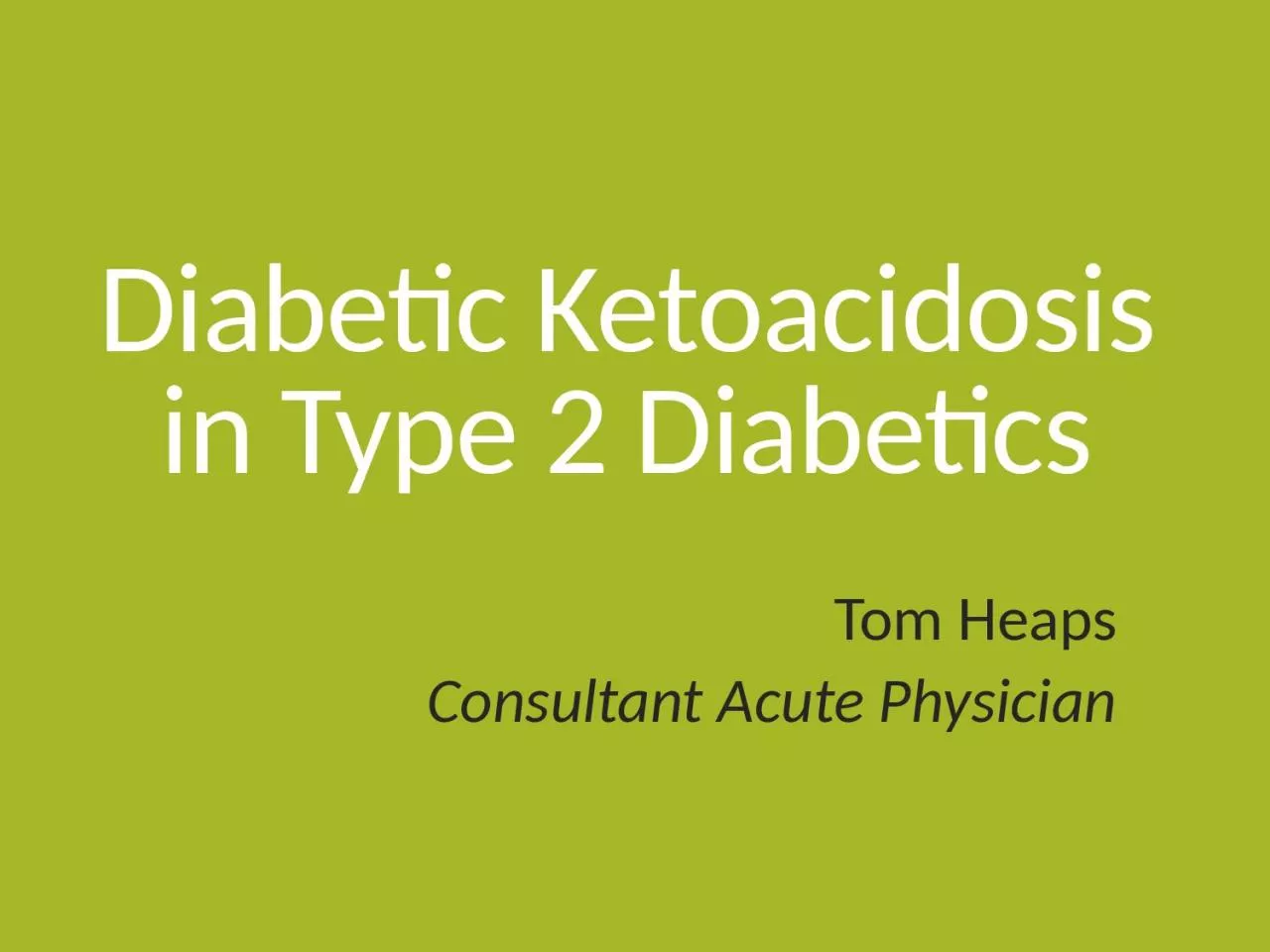

Tom Heaps Consultant Acute Physician Case 1 82yearold Caucasian female with T2DM gt30 years and HTN BMI 19 Metformin 500mg TDS Gliclazide 40mg BD Ramipril 5mg OD Admitted with 152 of increasing drowsiness confusion and reduced oral intake ID: 930072
Download Presentation The PPT/PDF document "Diabetic Ketoacidosis in Type 2 Diabet..." is the property of its rightful owner. Permission is granted to download and print the materials on this web site for personal, non-commercial use only, and to display it on your personal computer provided you do not modify the materials and that you retain all copyright notices contained in the materials. By downloading content from our website, you accept the terms of this agreement.
Slide1
Diabetic Ketoacidosis in Type 2 Diabetics
Tom Heaps
Consultant Acute Physician
Slide2Case 1
82-year-old Caucasian female with T2DM (>30 years) and HTN
BMI 19
Metformin
500mg TDS ,
Gliclazide
40mg BD,
Ramipril
5mg OD
Admitted with 1/52 of increasing drowsiness, confusion and reduced oral intake
Unwell, dehydrated,
hypotensive
CBG 46mmol/l,
ketones
3.2mmol/l
Na 158, urea 35,
creatinine
323 (baseline 77),
CRP 278
Urine dip leucocytes 3+, nitrite +
ve
, blood and protein 2+
VBG: pH 7.29, lactate 3.3, BE -8.9
Slide3Case 1
Does she meet the criteria for HHS?
Glucose >33.3mmol/l
Osmolality
= 2x [Na+] + glucose + urea = 2x 158 +46 + 35 = 397mOsm/kg (>320)
Does she meet the criteria for DKA?
Glucose >11mmol/l
Ketones
>3.0mmol/l or ≥3+ (urine)
Acidosis pH <7.30 and/or bicarbonate <15
How should she be treated?
DKA protocol?
HHS protocol?
Slide4Differences with HHS
p
resentation often
subacute
developing over days to weeks
glucose
often much higher than in DKA (usually >
33mmol/l)
more
profound dehydration (sodium very high and fluid deficit >
10l)
acidosis is not
required for diagnosis
(patients often are
acidotic
due to sepsis or
AKI)
ketosis
may
occur due
to starvation/acute
illness and/or acute insulin deficiency
fluid
deficit should be corrected more slowly
(e.g
. over
72h rather than 24h) due to risk of fluid shifts and cerebral oedema
FRIVII
is not required (
use rehydration alone initially then VRIVII reduced to 50
% of usual
rate
if
patient is insulin naïve)
10
% dextrose is rarely
required to maintain CBG
invariably
associated with severe precipitating illness e.g. MI,
sepsis; TREAT
prognosis
much worse (mortality up to 50%)
Slide5Case 2
67-year-old Caucasian male with T2DM diagnosed 10 years ago
BMI 32
On
metformin
1G BD and
lantus
32 units ON
Admitted with severe
cellulitis
of his right leg
CBG 29mmol/l, blood
ketones
6.5mmol/l
Sodium 134, urea 12.1,
creatinine
112
VBG: pH 7.22, lactate 2.1, BE -12
WHAT IS THE DIAGNOSIS?
HOW SHOULD HE BE TREATED?
Slide6DKA in patients with T2DM
Traditional teaching: levels of insulin in patients with T2DM are always sufficient to suppress
lipolysis
; DKA DOES NOT OCCUR IN T2DM
DKA in patients with T2DM is increasingly recognized
20-30% of patients admitted with DKA have T2DM in recent studies
often in association with stress/
intercurrent
illness (commonly infection/sepsis) in contrast to T1DM where no trigger to DKA is common
declining insulin levels in patients with longstanding T2DM
Release of stress hormones (
cortisol, glucagon, catecholamines, GH) inhibit oxidation of fatty acidspromotes hepatic ketogenesis further reduces insulin secretion and sensitivity
Slide7DKA in patients with T2DM
Should be treated as for DKA in T1DM (FRIVII) and discharged on insulin
Acute reduction in insulin secretion and action is reversible
β
-cell function recovers with time and insulin independence is achieved in 50% by 3-6m from index episode
may remain insulin independent for many years
70% suffer a repeat episode of DKA within 2y and progressive requirement for insulin with time
Chances of successfully coming off insulin or need for long-term insulin can be predicted by serial measurements of C-peptide levels in clinic ≥3w from episode of DKA
Slide8Case 3
21-year-old Afro-Caribbean male
Recently diagnosed diabetic by GP 1/52 ago after presenting with increased thirst and
polyuria
(CBG 29mmol/l)
BMI 28, some recent weight loss
Family history of T2DM (maternal grandfather)
Told by GP he needed to lose more weight, not started on any treatment, no plans for follow-up?!
Admitted via ED with abdominal pain and vomiting
CBG 27mmol/l, blood
ketones
7.8mmol/lSodium 136, urea 8.3, creatinine 102VBG: pH 7.15, lactate 2.2, BE -15 WHAT IS THE DIAGNOSIS? DOES HE HAVE TYPE 1 or TYPE 2 DIABETES? HOW SHOULD HE BE TREATED?
Slide9Ketosis-Prone T2DM (Type 1b or ‘flatbush
’ diabetes)
More common in non-white patients with T2DM (especially Afro-Caribbean and Hispanic ethnicities)
DKA common at time of presenting with diabetes
Recurrent episodes of DKA may occur with no obvious trigger other than prolonged hyperglycaemia
Reversible hyperglycaemia-induced suppression of
β
-cell function – ‘glucose toxicity’
Genetic polymorphisms in islet cell transcription factors e.g. PAX4 and glucose-6-phosphate
dehydrogenase
deficiency more common in patients with KPT2DM
Islet cells more susceptible to hyperglycaemia-induced oxidative stressRecovery of β-cell function and insulin independence is common following resolution of DKA
Slide10Determining whether patients have T1DM or T2DM at presentation (with DKA)
Age is a poor discriminator; 20-30% of T1DM presents >20 (including LADA) and (KP)T2DM may present in childhood
Short history of
polyuria
,
polydipsia
and weight loss may occur in KPT2DM
Non-white ethnicity and family history of diabetes more common in (KP)T2DM
Patients with T2DM are more likely to be obese and have higher levels of HbA1c (e.g. >10%) at presentation
Pancreatic
autoantibodies
(anti-GAD, anti-ICA and anti-IA2) are more common in T1DMPersistence of insulin independence >6-12m and normal/high fasting C-peptide levels following resolution of DKA are best discriminators
Slide11Spectrum of DKA in T2DM
Slide12Key Learning Points
DKA is relatively common in patients with T2DM
Distinguish different subtypes/phenotypes
Treat HHS with ketosis/acidosis as HHS
Treat true DKA in T2DM as for T1DM and discharge on insulin
Important to consider KPT2DM in non-white obese patients who present for first time in DKA
Check
autoantibodies
and fasting C-peptide levels in clinic
Majority can achieve prolonged periods of stability on oral
hypoglycaemics
after recovery of β-cell function